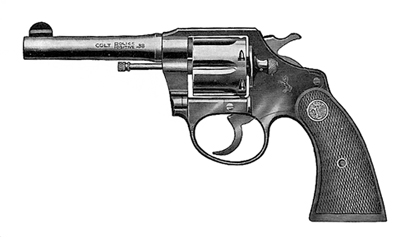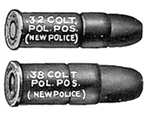
 The Colt Police Positive is the Rodney Dangerfield of revolvers. It don’t get no respect.
The Colt Police Positive is the Rodney Dangerfield of revolvers. It don’t get no respect.
Normally, the word “Colt” is pure magic to collectors. Put that name on a gun, and shazam! It’s an instant collectible. This rule applies not only to Pythons and Diamondbacks but to real stinkeroos like the ill-fated Model 2000 All-American 9 mm semiauto, too.
The Police Positive is the one glaring exception. I have seen buyers at gun shows pass over cherry Police Positives to fondle things like H&R Model 929s, Iver Johnson Cadets and High Standard Sentinels. These are all nice guns, but really, now. Let’s be serious.
I once had a 4-inch Police Positive .38 I could not give away. I had taken a nicer one in trade and decided to pass the old one on to someone who would appreciate it. I offered it to my brother, my son, my wife, my neighbor and my neighbor’s grandmother. All of them said thanks but no thanks. It wasn’t a dog, either, but a nice 80 percent specimen from 1923. Once, I left it in my car at a gun show along with half a bag of cold White Castle sliders. When I came out, the burgers had been stolen, but the revolver was still there. Finally, I sold it back to Phillip Peterson, who took pity on me and gave me 30 percent of what I originally paid him for it.
The Police Positive’s virtues are many: It’s rugged, stylish and just about foolproof. Its faults are that it lacks adjustable sights (except for the Target versions), and fires cartridges that are a little on the pricey side and somewhat underpowered (.32 S&W Long/.32 Colt New Police and .38 S&W/.38 Colt New Police). Still, the Police Positive gave rise to a family of collectible Colts, and by garsh, that should count for something!
Turn to the Right
The Police Positive saw the light of day in 1905, when it debuted as an improvement on the old square-butted Colt New Police double-action six-shooter introduced in 1896. The Police Positive’s name sprang from its “positive” — that is, foolproof — internal hammer-block safety, a feature that had been conspicuously absent from its predecessor. Another improvement from the old New Police was the Positive’s .38 S&W chambering, a cartridge Colt cloned under the name of .38 Colt New Police.
Built on the Colt .32 double-action frame introduced in 1893, the classic Police Positive was chambered in .32 or .38 Colt New Police (and their S&W counterparts, of course) and could be had with a 21/2-, 4-, 5- or 6-inch barrel. The finish was nickeled or blued steel, and grips were checkered walnut with a gleaming white-metal rampant colt medallion. Sights were fixed and consisted of a half-moon blade front and a hog-waller groove milled into the topstrap. Early production samples had a plain topstrap, but later ones had a matte topstrap. In all, the Police Positive made a fine-looking package.
Colt liked to talk up the accuracy of the Police Positive and emphasized that its cylinder rotated toward the frame, unlike the revolvers of a certain Springfield, Mass., gunmaker, whose cylinders rotated away from the frame. As one Colt advertisement stated: “All Colt Cylinders TURN TO THE RIGHT.”
The accuracy of any revolver is determined greatly by the method used in lining up the chambers of the cylinder with the barrel. All Colt Cylinders turn to the right — thus binding the crane tight against the frame of the revolver — guaranteeing perfect alignment of chamber and barrel and adding materially to the accuracy of the arm.
The Offspring
Judging from the frequency with which I find Police Positives on the used-gun market, Colt must have made a billion of them. Yet today, the Police Positive isn’t remembered for the gun that it was but rather for the guns it inspired. Most collectible Colt double-action revolvers of the second half of the 20th century are based to one extent or another on the Police Positive.
Here are the collectible offspring of the decidedly noncollected Colt Police Positive.
Police Positive Target: This was a .32- or .22-caliber version of the Police Positive with a 6-inch barrel and adjustable front and rear sights. It was manufactured from 1905 to 1941. In today’s market, the .32 version actually seems more desirable than the .22.
Police Positive Special: This was basically a Police Positive with a 1/4-inch longer frame to accommodate the .38 Special and .32-20 cartridges (in addition to the .32 and .38 New Police and their S&W counterparts). Features include fixed sights, a square butt, and 4-, 5- or 6-inch barrel lengths. It was manufactured from 1908 to 1970 in three issues, and then reintroduced briefly in 1995.
Detective Special: This is Colt’s classic snubbie. It’s basically a round-butted Police Positive Special chambered in .32 Colt or .38 Special with a 2-inch barrel. The first issue was manufactured from 1926 to 1972 and is quite collectible. The second, made in 1993, featured a barrel shroud and neoprene grips. And the third was a stainless-steel variant called the Detective Special II, or D-SII, manufactured from 1997 to about 1999. Yet another stainless variant, the Magnum Carry, was introduced in 1998 and was chambered in .357 Magnum.
.38 SF-VI: This was basically a stainless-steel Detective Special chambered in .38 Special with a modern transfer-bar safety and a 2- or 4-inch barrel. It was manufactured from 1995 to circa 2000.
.38 SF-VI Special Lady: This was similar to the preceding gun, but with a bobbed hammer for double-action-only operation and a bright stainless finish. It was manufactured from 1996 to circa 2000.
Banker’s Special: A short-butted version of the Police Positive, this gun had a 2-inch barrel and was chambered in .22 LR and .38 Special. The gun is highly collectible, with 35,000 manufactured from 1926 to 1943.
Cobra: This was a lightweight, alloy-framed version of the Detective Special chambered in .22 LR, .32 Colt/S&W, .38 Special (first issue) and later .38 Special only (second issue). Second-issue guns had a shrouded extractor rod and ramp front sight. It was manufactured from 1950 to 1973 in both issues.
Agent: Basically a Cobra with a shortened grip frame, this gun was manufactured from 1955 to 1986 in two issues. The first, made from 1955 to 1973, had an unshrouded extractor. The second, made from 1973 to 1986, had a shrouded extractor and ramp front sight.
Courier: This was a 3-inch version of the first-issue Agent chambered in .32 Colt/S&W and .22 LR. The gun is scarce, and it was only made from 1955 to 1956.
Border Patrol: Essentially a Police Positive Special with a 4-inch bull barrel and chambered in .38 Special, this is the rarest of the Police Positive clan. Only 400 were manufactured in 1952. Beware of fakes!
Aircrewman Special: This all-aluminum Detective Special was chambered in .38 Special and made for the U.S. Air Force in 1951. It’s exceedingly rare, as most were thought to have been destroyed. Only 1,200 were produced.
Diamondback: This gun resembles a Python built on the Police Positive Special frame rather than on the big .41 Army frame. Chambered in .38 Special and .22 LR, it was manufactured from 1966 to 1986. It’s a very hot collectible.
Viper: Basically an alloy-framed version of the Police Positive Special chambered in .38 Special, this was made from 1977 to 1984.
Respect, Please
Sometimes the tree falls pretty far from the apple, I guess. The original Police Positive is doomed to languish forever in the shadow of its more desirable offspring, and there’s nothing that can be done about it. The collectibility of the Police Positive’s descendants proves, however, what a sound design the old-timer really was.
So, hey! Show a little respect.

Next Step: Get your FREE Printable Target Pack
Enhance your shooting precision with our 62 MOA Targets, perfect for rifles and handguns. Crafted in collaboration with Storm Tactical for accuracy and versatility.
Subscribe to the Gun Digest email newsletter and get your downloadable target pack sent straight to your inbox. Stay updated with the latest firearms info in the industry.


![Best Concealed Carry Guns In 2025 [Field Tested] Wilson Combat EDC X9S 1](https://gundigest.com/wp-content/uploads/Wilson-Combat-EDC-X9S-1-324x160.jpg)


![Best 9mm Carbine: Affordable PCCs [Tested] Ruger Carbine Shooting](https://gundigest.com/wp-content/uploads/Ruger-Carbine-Shooting-100x70.jpg)
![Best AR-15: Top Options Available Today [Field Tested] Harrington and Richardson PSA XM177E2 feature](https://gundigest.com/wp-content/uploads/Harrington-and-Richardson-PSA-XM177E2-feature-100x70.jpg)

[…] other type revolver that could have been issued. The .38 Colt Official Police was on a .41 frame (Colt Police Positive was smaller frame, as was Detective Special — but not issued, while the S&W was on a regular […]
I will take any police positive anybody wants to give away!!
this now is BS; any old Colt in good condition is valuable
… [Trackback]…
[…] Informations on that Topic: gundigest.com/gun-collecting-firearm-collecting/colt_police_positive […]…